Nearly three-quarters of employees believe their leaders need to be better equipped to meet today’s challenges.
Our latest research reveals a crisis in leadership and uncovers the most important characteristics employees seek in their leaders.
In an era defined by constant and significant disruption, employees are increasingly looking to business leaders for guidance and clarity.
President Trump’s return to office and implementation of protectionist economic policies has fuelled instability across global markets. Add to this the threat of a full-scale trade war, escalating conflicts, climate volatility, social inequality, and the rapid advance of AI – and it’s clear that today’s leaders aren’t just running business as usual. They’re navigating a tumultuous global landscape.
But how well equipped are leaders to face these new challenges and, crucially, what are the qualities that employees look for in their leaders?
In our latest research, we posed both these questions to desk-based employees of large organisations – and the answers are striking:
Nearly three quarters (70%) of 1,001 desk-based employees of large companies say their senior leaders are not very well equipped to lead effectively in an increasingly chaotic global business environment.
This finding reveals there is a distinct lack of confidence in the abilities of those in senior leadership teams to adequately meet the challenges of today’s world. Levels of confidence vary according to respondents’ gender, industry and role, but the message is consistent: leaders are falling short of what this moment demands.
Our research also reveals the qualities employees value the most in their senior leaders – with two characteristics rising to the top: ‘clear communication’ and ‘a clear purpose, beyond just making money’. These results echo a growing demand for leadership that is not only decisive, but also meaningful.
Share this article
But why do these insights matter?
Consistent research indicates that when employee confidence erodes, workplace performance suffers, culture weakens, and talent retention drops.
The results of our survey offer a rare and timely glimpse into how leadership is being experienced on the ground – and what qualities employees really need from senior leaders in times of great uncertainty.
23%
The results of our survey offer a rare and timely glimpse into how leadership is being experienced on the ground – and what qualities employees really need from senior leaders in times of great uncertainty.
In this piece, we’ll reveal the most important traits of good leaders, and provide five essential strategies leaders must adopt now to lead effectively in this moment – when trust is fraying, expectations are shifting, and the stakes have never been higher.
These strategies will see today’s underperforming leaders become tomorrow’s great ones. Leaders who don’t retreat into short-term thinking or strongman posturing, but step up with clarity, conviction, and a responsibility that extends beyond the bottom line.
A reality check for leadership
Trust in leadership is under pressure.
Recent studies – including Edelman’s Trust Barometer and The Purpose Gap from Given, part of Anthesis – reveal a growing disconnect between what leaders say and what employees experience.
Edelman reports a 21% rise in distrust towards business leaders over the past four years. Meanwhile, The Purpose Gap found that over half (52%) of employees believe there’s a clear gap between the stated purpose of an organisation and its actual behaviour.
Our latest research adds further weight: less than a quarter (23%) of employees in large organisations believe their leaders are ‘very well equipped’ to handle today’s turbulent business environment. Nearly half (48%) think their leaders are only ‘somewhat’ prepared, and one in five (22%) hold a distinctly negative view.
It is clear that in the eyes of employees, senior leaders in large businesses have some work to do.
There were some differences between industries, which can be explored in the graphs on the following page.
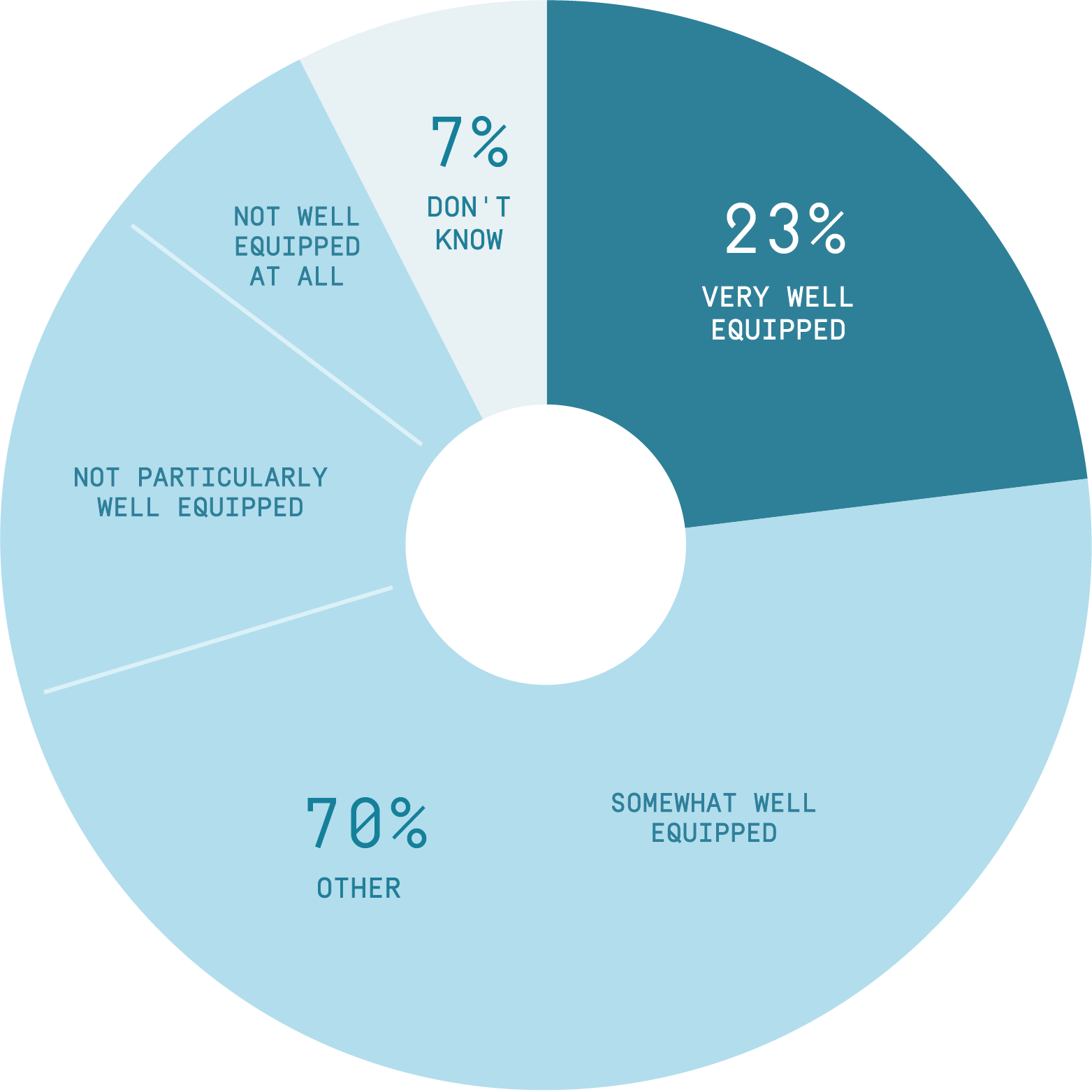
Our research suggests, out of 11 industry categories, the three sectors with the lowest confidence in their leaders were:
- Legal
- Sales & Marketing
- Manufacturing & Utilities
By contrast, respondents in the following sectors displayed the highest confidence levels:
- IT & Telecoms
- Finance
- Architecture, Engineering & Building
These are categories that are at the sharp end of the changes in the world, so it is positive to see confidence that the right people are guiding the ships.
Confidence in leaders by sector

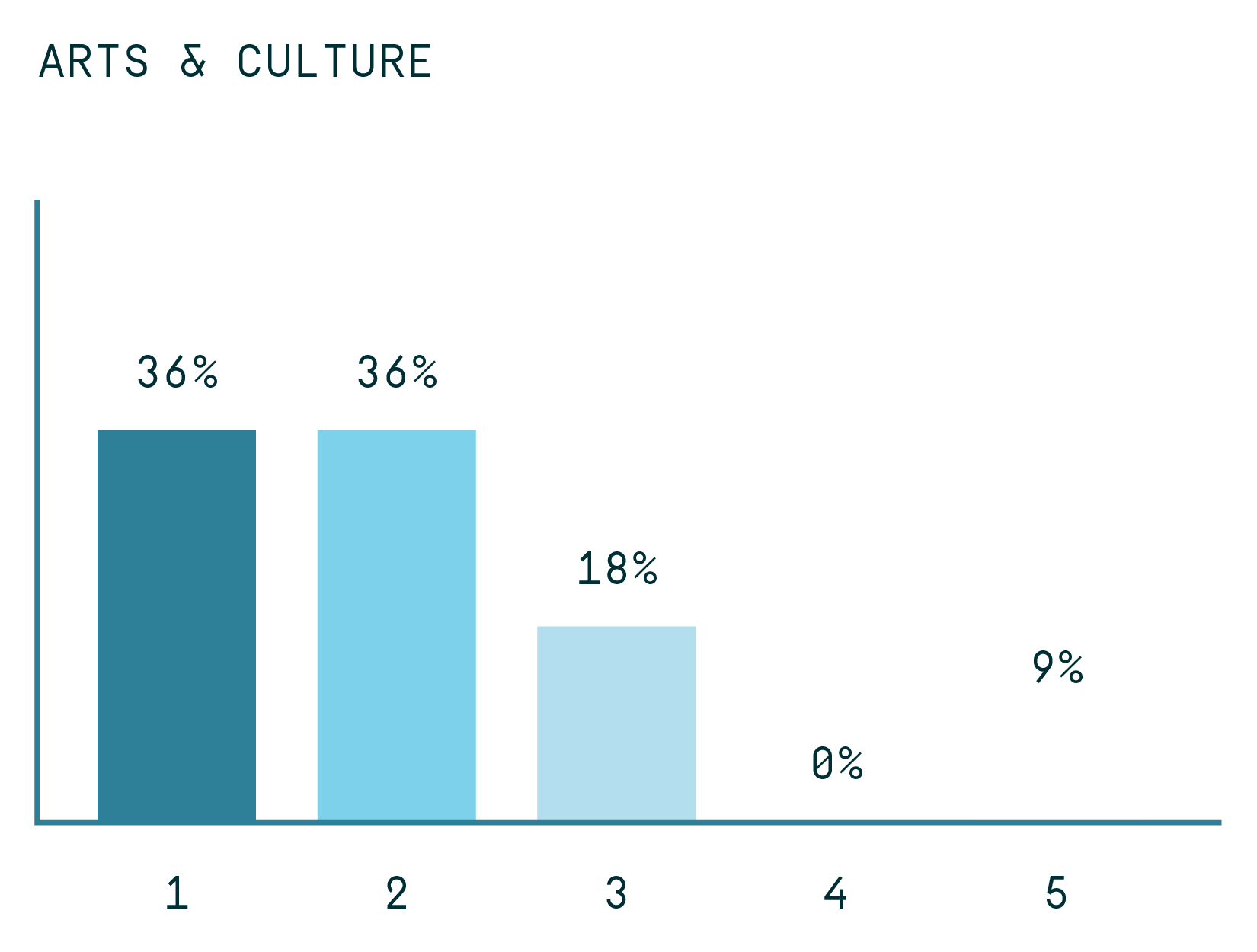

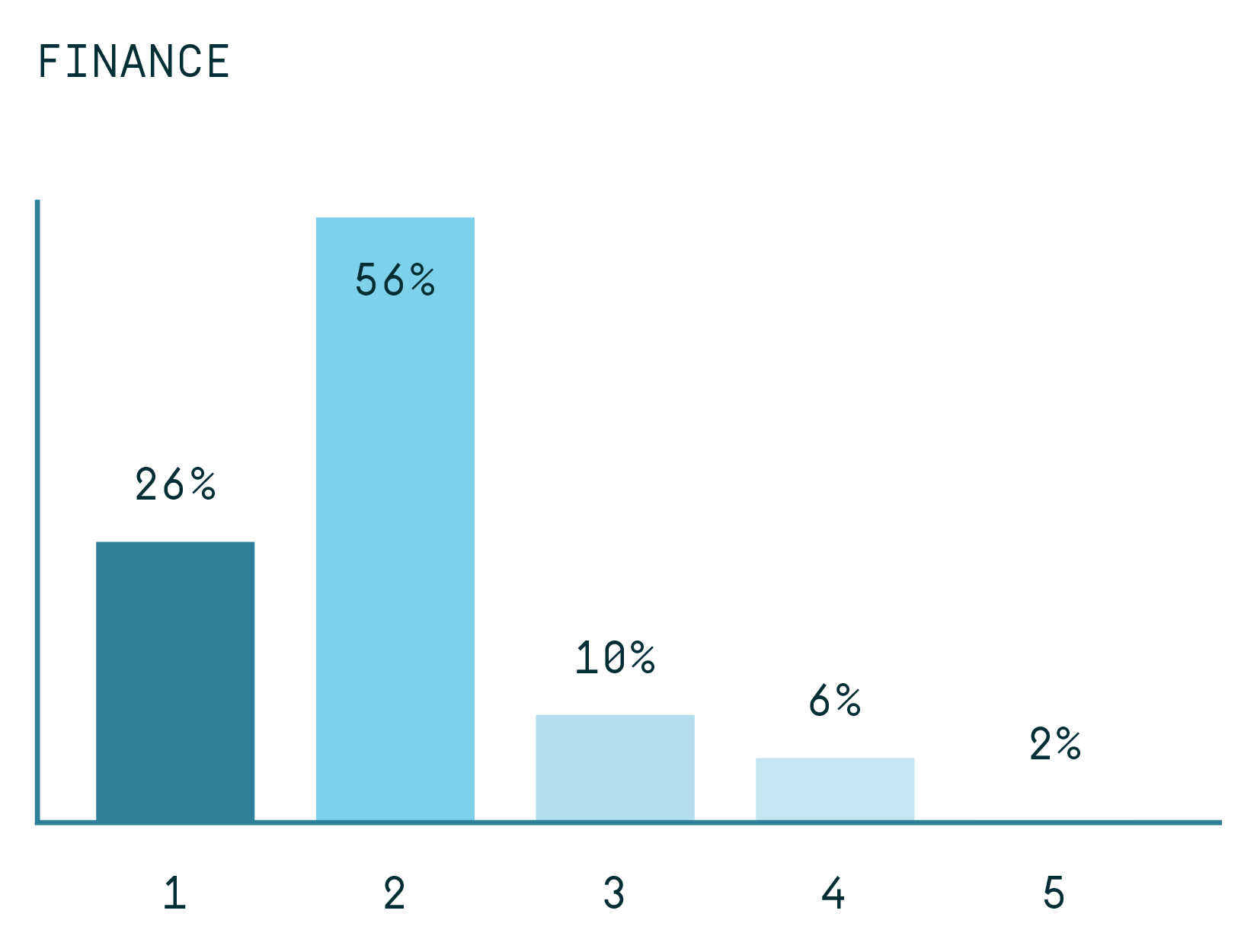
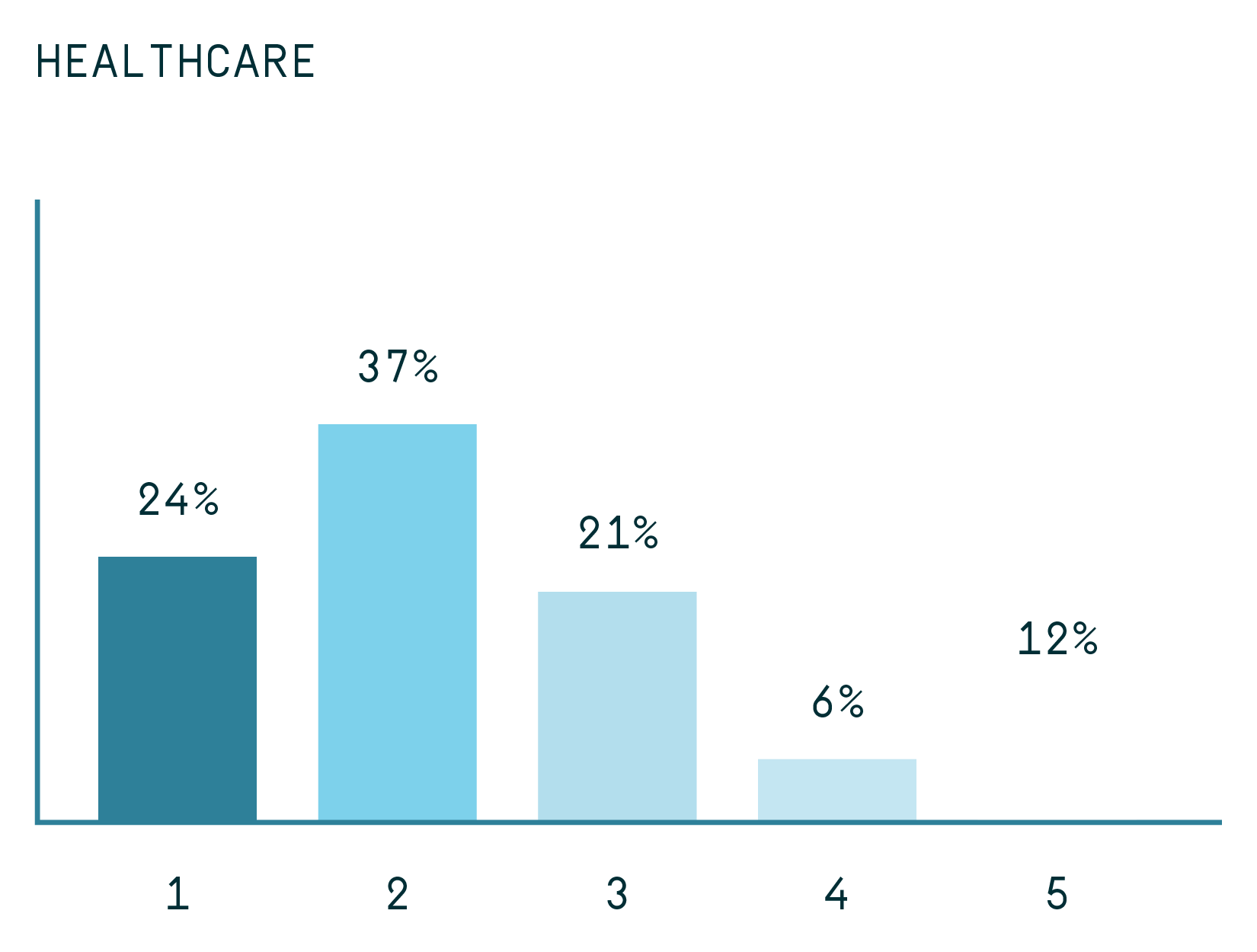

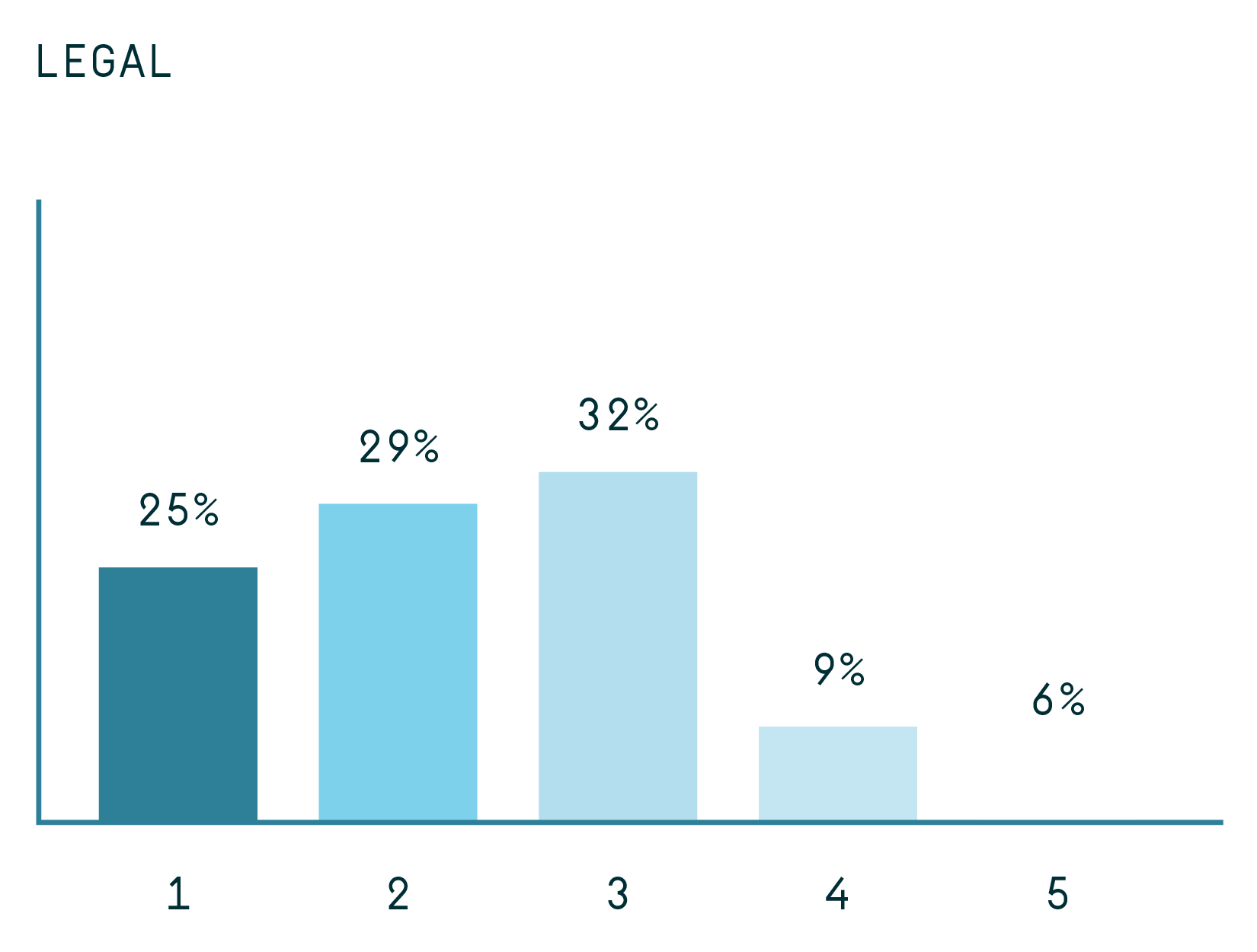
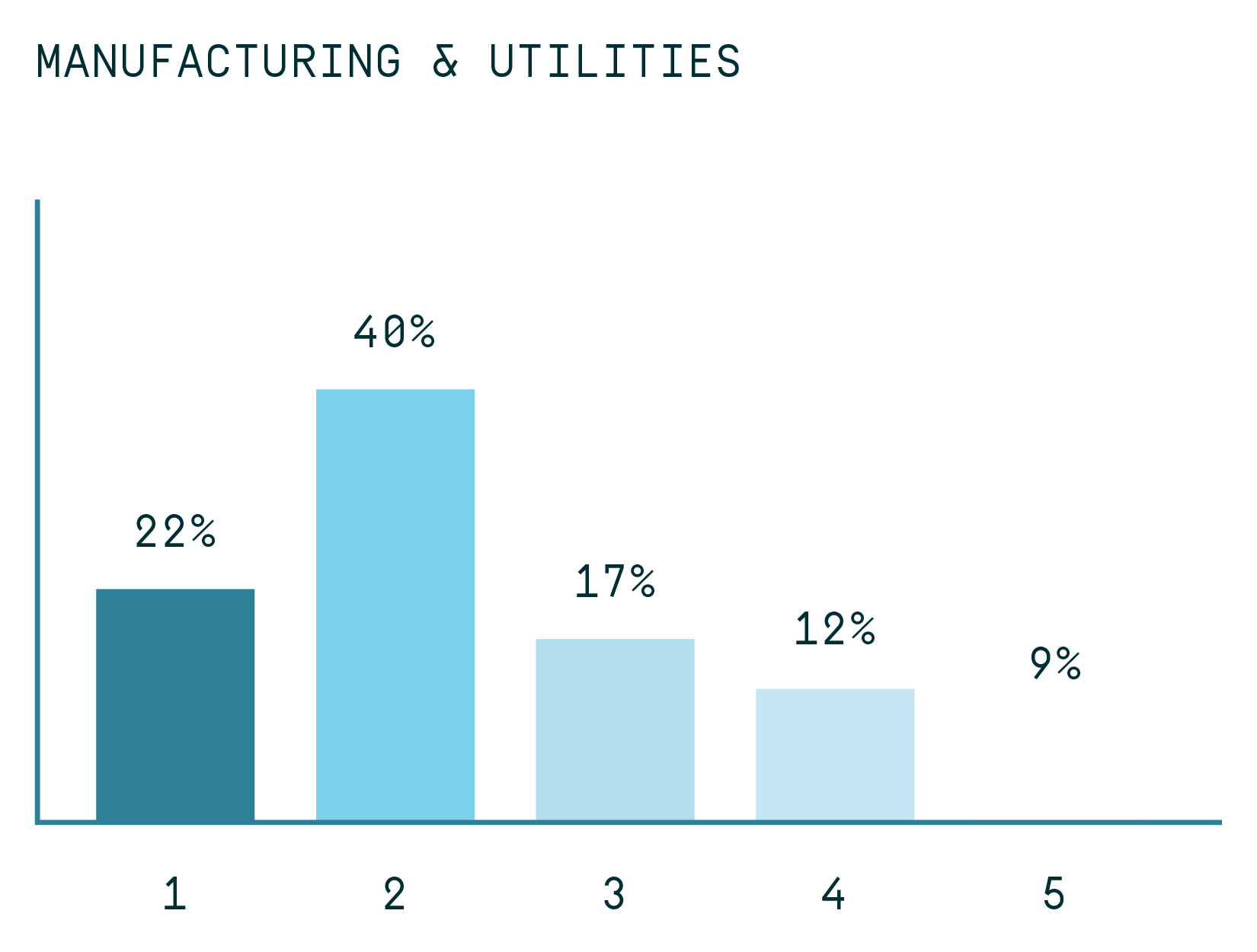
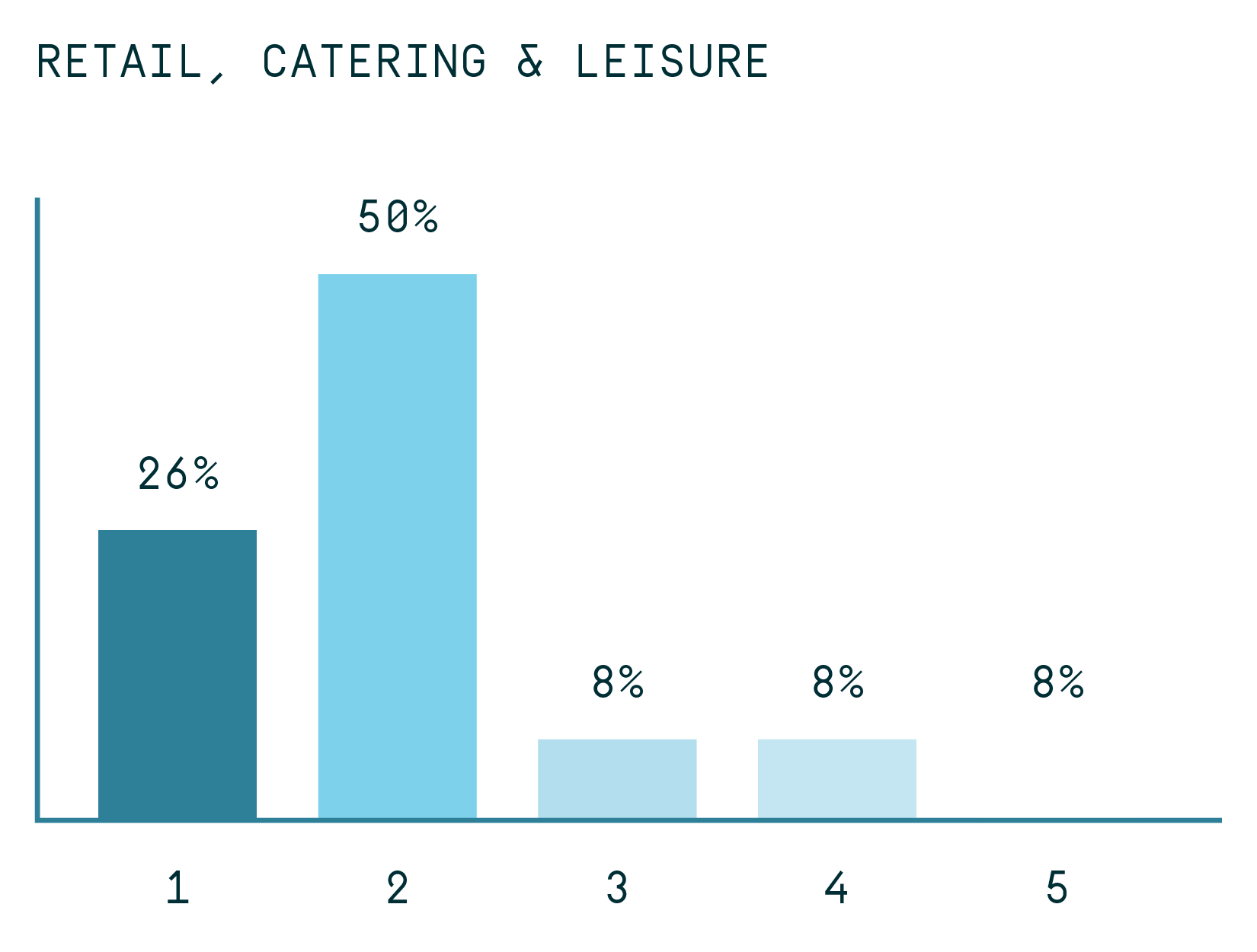

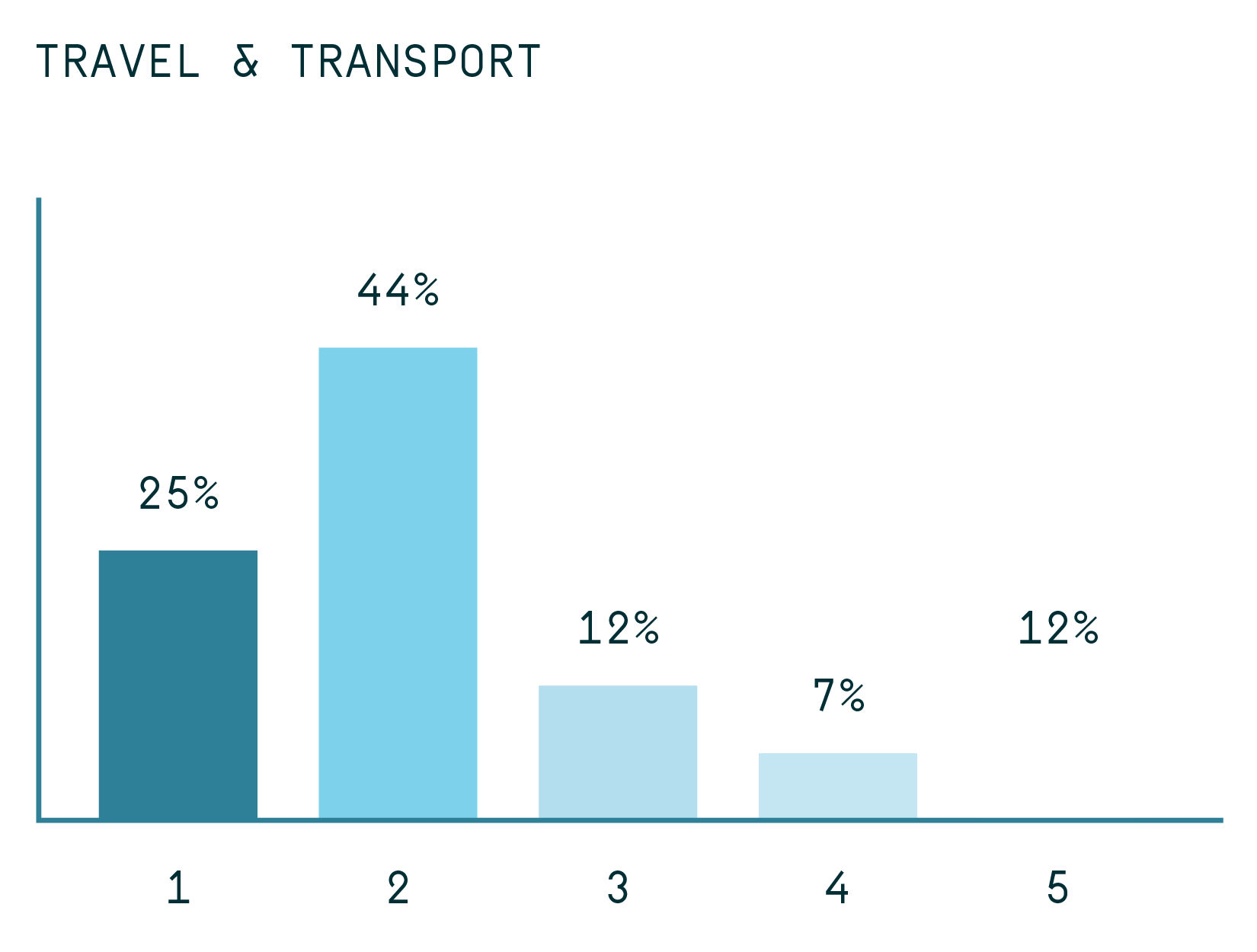
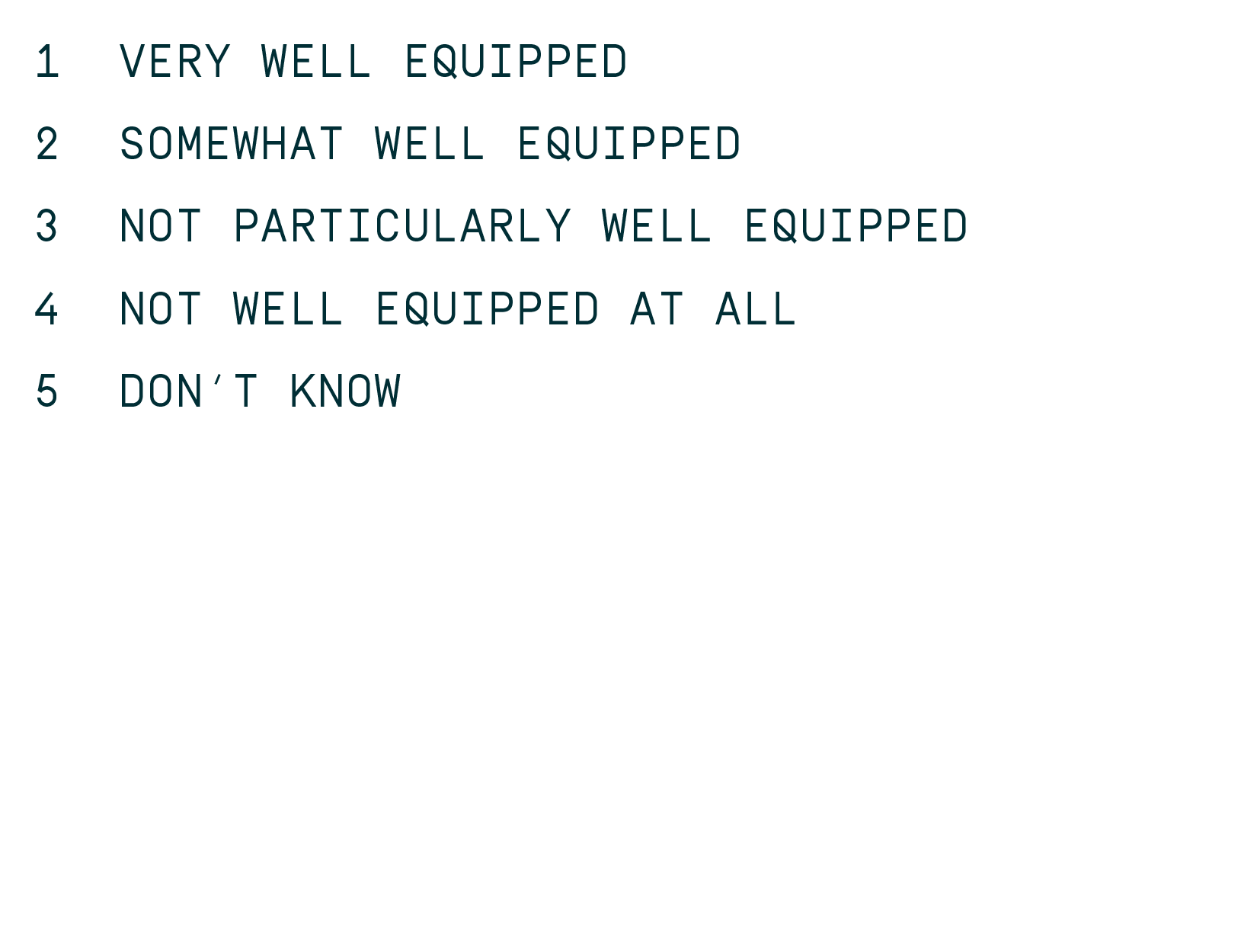
Qualities for effective leadership
It’s indisputable that over the last decade, the role of business leaders has become more complex. But as mounting evidence suggests, the majority of leaders do not have all of the tools they need to lead effectively.
43%
As part of our research, we asked what employees look for in their leaders – and it’s these findings, which perhaps offer the most value. They provide a vital roadmap for those ready to lead with greater impact.
Our poll shows one quality stands head and shoulders above the rest: ‘clear communication’.
When asked to choose the top three most important skills a senior leader should have, nearly half (43%) of employees said they valued communication above other qualities. Employees want to hear from their leaders on both the good and bad to provide reassurance and a sense of unity in times of uncertainty.
The second most-valued quality was ‘a clear purpose, beyond just making money’ (28%). Despite the short-term turmoil, people are looking for leaders with vision and conviction they can get behind. The ‘we’re here to make money’ mantra of old just doesn’t cut it in terms of the incentivisation of a workforce.
In fact, ‘making as much profit for the company as possible’ ranked last out of a choice of 11 characteristics, with only 13% citing it as a desirable leadership trait. Employees are sending a powerful signal that the leaders who inspire trust and commitment are those who stand for more than the bottom line.
There are also important differences across demographics. Women placed even more emphasis on communication and purpose, while men were more likely to value tough decision-making.
These insights aren’t just interesting – they’re actionable. They give today’s leaders a blueprint for building trust and motivating their teams. But to truly lead effectively, senior leaders must approach these findings with honesty and integrity. It takes courage to reflect on your own personal qualities – and where they may be falling short.
By turning the performance lens on themselves, leaders can use these findings not just as feedback, but as a roadmap for growth – and a guide to becoming the kind of leader their teams truly need.
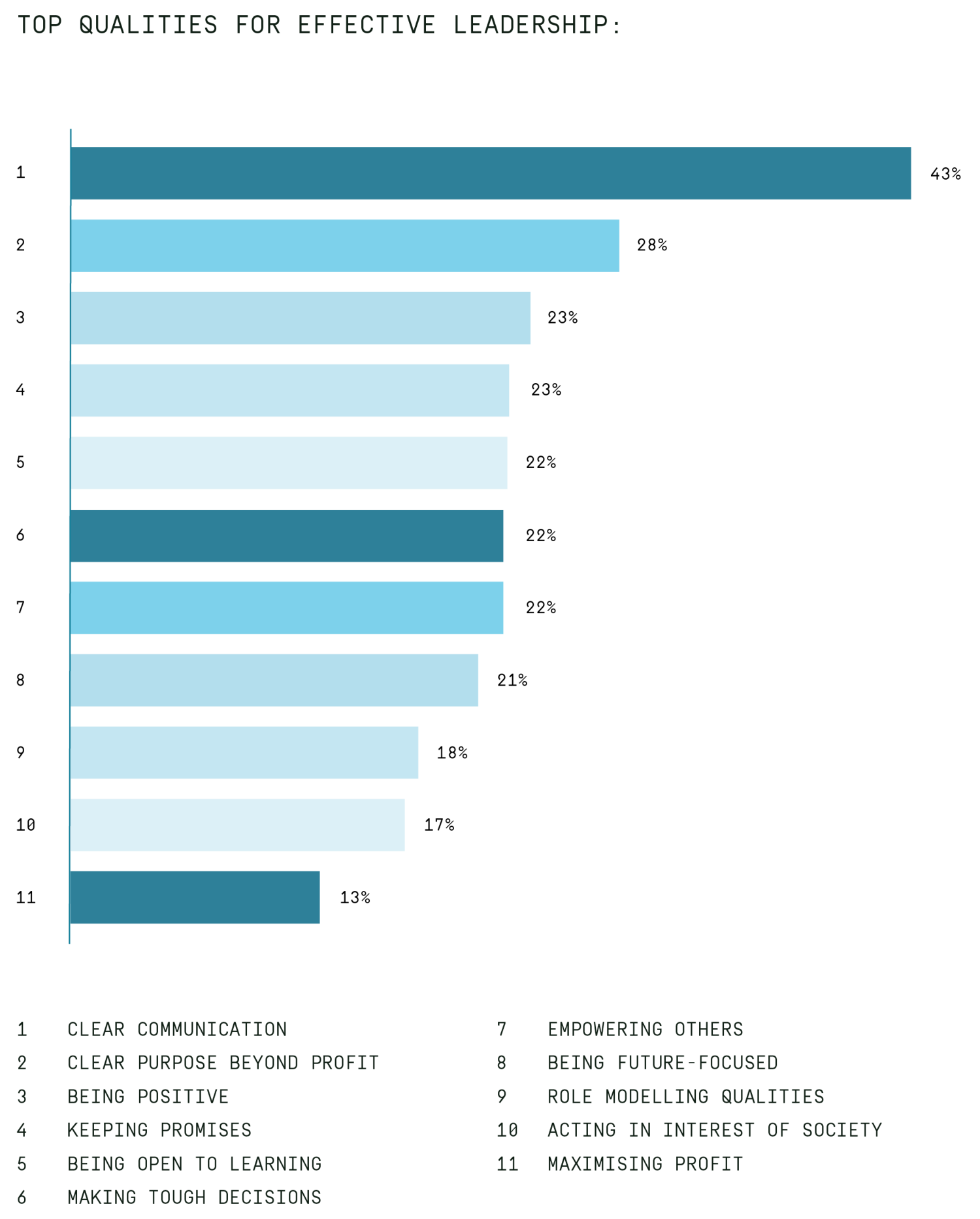
Five strategies for purposeful leadership in uncertain times
In addition to the qualities a leader needs to demonstrate, we have also identified five core strategies for CEOs and business leaders to adopt now.
Based on our own extensive experience and expertise working with leaders and their teams, read on to discover the new approaches that will help leaders to deliver successful, sustainable performance in an era defined by uncertainty.
1. No compromise on performance
With the UN’s ‘Decade of Action’ at its halfway point, some organisations are already scaling back their ambition as the 2030 targets begin to draw closer. As a result, business leaders who want to maintain a progressive, profitable long-term agenda will need to focus relentlessly on commercial performance.
“It is good business to be a good business.“
Jesper Brodin, CEO of INGKA Holding
Sustainability and social responsibility cannot be an adjunct, a business cost or merely a campaign. Those who lead successfully in this arena do so by building strong business cases that remove any semblance of compromise.
Today’s leaders need to demonstrate to all stakeholders – but especially to the investor community – that long term-business planning depends on building resilience and sustainability. This isn’t about being ‘woke’. It’s about being commercially resilient in the future. It’s about being ready for what’s next.
The good news is there’s mounting proof that you don’t have to choose between profit and purpose. The Word Economic Forum’s Alliance of CEO Climate Leaders achieved a collective 10% reduction in emissions, while simultaneously increased their revenues by 18% in just three years.
And the Sustainability for Business Resilience Report 2024 shows nearly 9 in 10 business leaders agree: integrating sustainability strengthens their organisation’s resilience.
Critically, leaders must tell this story of sustainability through a lens of uncompromising commitment to business performance.
Our latest research indicates that effective communication is the most vital of tools in demonstrating intent and commitment to performance both internally and externally.
This isn’t greenhushing – it’s a smarter, more commercial way of framing sustainable performance. Using language centred on efficiency, innovation, and growth helps stakeholders see the value in a long-term agenda.
We’re already seeing leaders strike this balance. Among them, Jesper Brodin and his team at IKEA show what’s possible when you treat sustainability as a performance driver – not a cost. As Brodin says: “It is good business to be a good business.”
Speak to us for a free leadership workshop to explore the strengths and weaknesses within your team or organisation, and learn how to adopt strategies which can unlock sustainable performance.
2. New agility
Agility is often cited as essential to modern leadership – and with good reason. Today’s leaders are operating in a state of near-constant disruption, where the ability to adapt quickly is no longer a nice-to-have but a baseline expectation for C-suite members.
But true agility goes beyond fast decisions. It requires continuous learning, humility, and self-awareness. This can be difficult to accept for those at the height of their professional careers.
Our research found that ‘being open to learning’ ranks among the top five qualities employees value in senior leaders – a reminder that even those at the top must remain students of the world around them.
Agility has in the past been used as an excuse for opting out of the longterm agenda. This is not a mandate for compromise or retreat.
The best leaders are those who adapt in the moment while staying focused on sustainable performance. They surround themselves with diverse, informed voices – making bold decisions rooted in insight, not instinct.
WE DEFINE NEW AGILITY THROUGH FIVE KEY CAPABILITIES:
I.
Temperament
Are you able to make and present calm, rational and well-informed decisions in the face of rapidly changing environments?
II.
Beliefs
Can you maintain core beliefs and remain focused on your North Star while adapting quickly to changing circumstances?
III.
Skills
Are you able to increase your awareness, understanding and capabilities around rapidly emerging subjects or disciplines?
IV.
Support
Can you delegate and empower others to support you where you have gaps in skills, experience or knowledge? Can you offer guidance and mentorship to develop those that need it?
V.
Communication
Can you do all of the above and take people on the journey with you, delivering the balance between transparency and comfort?
3. Enable followership
Although leadership is an idea that dominates in organisations, it is a narrow concept: focused on individuals rather than the cultures they create. In our experience, ‘followership’ is just as critical in organisational outcomes.
To be clear, the concept of followership is not about passive obedience, but about engaged, values-driven people who actively support and shape the culture around them.
The idea of ‘exemplary followership’ highlights the latent potential of people within organisations who aren’t just led, but who think critically, act with purpose, and take ownership. More recent studies indicate that strong followership directly improves leadership effectiveness.
Yet this sits counter to the current image being projected of leadership being about strong individuals and concentrated power.
In a world where populist and egoistic traits have become mainstream and almost expected, senior leadership teams will need to challenge this narrative — replacing it with individual autonomy, empowered teams, and collective intelligence.
To encourage followership, tools such as effective communication, offering and receiving support and seeking out diverse perspectives consistently rank highly in leadership attribute surveys – including in our own latest research.
Using a framework such as the Inner Development Goals (pictured below), leaders can assess and develop the inner skills their teams need – like empathy, resilience, and critical thinking – to build more conscious, collaborative, and purpose-driven cultures that enable sustainable performance and positive impact.
When done well, ‘exemplary followership’ doesn’t just support leadership. It builds the next generation of it.
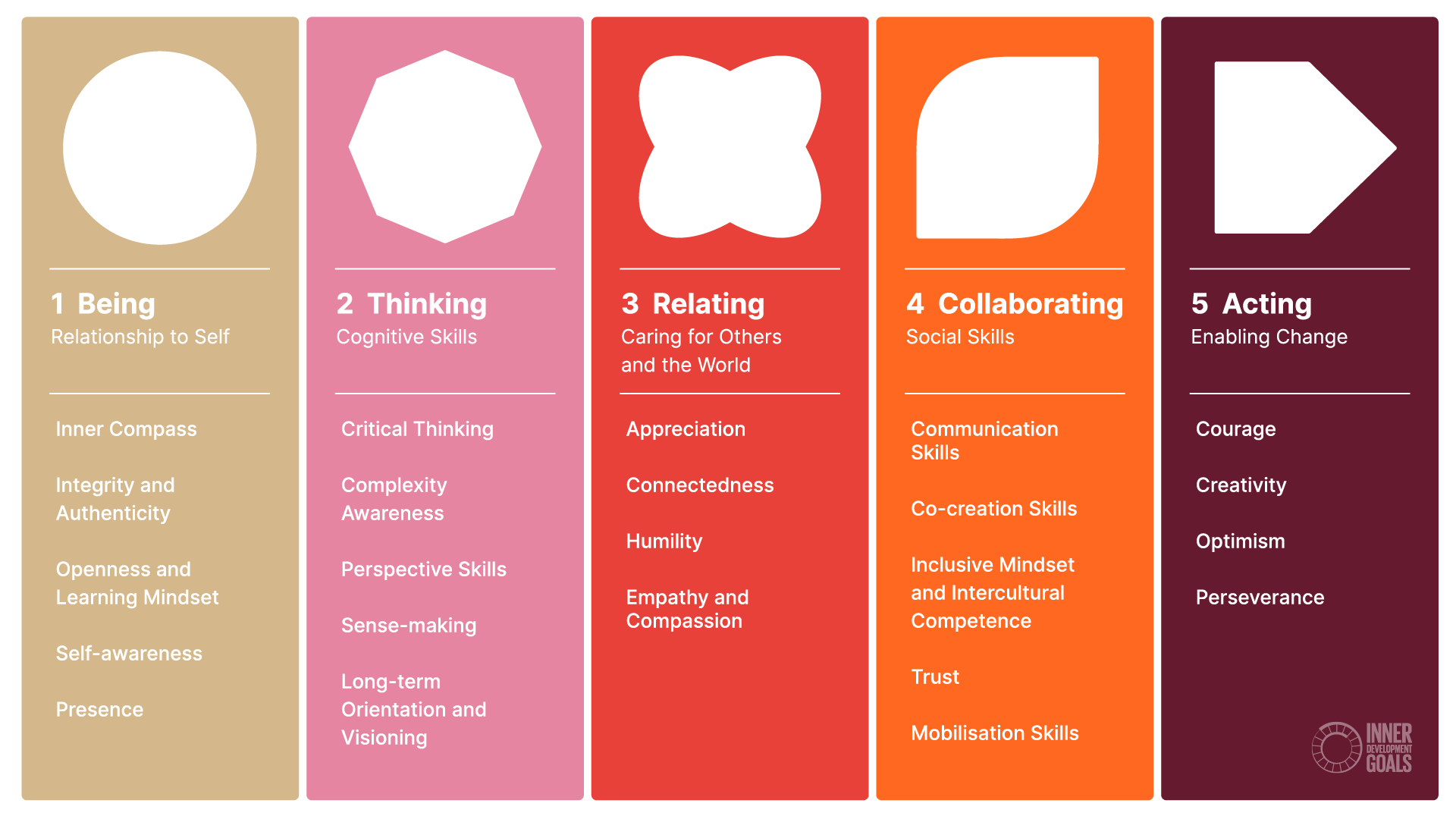
4. Stay close to the action
Our new research reveals that more than three-quarters of employees believe their leaders aren’t very well equipped to meet today’s challenges. This echoes findings from our recent Purpose Gap Report, which uncovered a similar disconnect – this time between how C-suite leaders perceive their organisation compared to how middle managers experience it.
The message? Leaders are often too far from the reality of day-to-day operations.
The mandate for sustainability is often set from senior executives, fully bought in and incentivised to deliver. But their success hinges on mid-level executives – “the cohort of hidden actors and unsung heroes” as Paul Polman et al. described them in a recent article written for the Harvard Business Review.
“The success or failure of sustainability initiatives often depends on a cohort of hidden actors and unsung heroes: an organisation’s mid-level executives and team leaders.“
Paul Polman, founder and co-chair of Imagine, and former CEO of Unilever
As our own research demonstrates, it’s this cohort who crave a clear purpose, beyond just making money. In our poll, this quality was selected as the second most important leadership value after communication.
So how do business leaders provide that ‘clear purpose’ middle managers are looking for to help them deliver vital initiatives?
To meet that need, leaders must get closer – both to the work, and to the people delivering it.
This is particularly relevant in sustainability where complex regulation and reporting creates layers between executives and the reality of the work going on in their businesses.
Agile leaders who have taken the time to understand the complex sustainability agenda will be able to tackle on-the-ground challenges, building trust, sharpening decision-making, and helping spot gaps early.
It also means knowing your people: what support, skills or freedom do your middle managers need to succeed? How do you empower them to lead confidently without fear of failure or repercussion?
The most effective leaders model the behaviours they want to see. They lead with clarity, connect across teams, and create the conditions for others to thrive.
Again, clear communication, persuasive business cases and incentives are key to this.
5. Own your legacy
As we hit the halfway mark in the 2020s, a decade heralded as critical in the future of humanity, many leaders are thinking about what they will leave behind.
Legacy is a powerful motivator – an innate human trait focussing on the impact you want to make and how you’ll be remembered. While it can be fuelled by negative drivers – ego, vanity or existential angst – it can also offer clarity and purpose.
With the average CEO in the UK aged 55 years (Spencer Stuart Board Index, 2024), legacy thinking can provide focus: lifting leaders out of short-term firefighting and aligning them to a bigger vision rooted in values, not just quarterly goals.
The idea of legacy usually hinges around making a positive impact based on personal values and a bigger purpose, rather than just hitting the targets of the commercial cycle.
“There is no greater thing you can do with your life and your work than follow your passions – in a way that serves the world and you.”
Richard Branson, founder of Virgin Group
Leaders who can understand and plan for a legacy will be better able to navigate the complexities of the changing environment with the courage required to make difficult choices and build something that outlasts their tenure and creates real, lasting change.
Responding to this moment
Our latest research reveals a distinct gap between what employees need from their leaders and what they’re currently experiencing in a world in flux.
With less than a quarter of respondents in our survey believing their senior leaders are ‘very well equipped’ for today’s challenges, it’s clear that traditional approaches to leadership are falling short.
And once employees lose trust in their leaders, it becomes significantly harder to inspire, align, and retain teams. Productivity drops, engagement wanes, and the path to meaningful change becomes harder and more uncertain.
The road ahead requires more than charismatic figureheads or bold statements – it demands leaders who are present, open to learning, committed to sustainability, and capable of creating meaningful followership. And while some sectors are faring better than others, confidence gaps across industries indicate this is not an isolated issue, but a systemic one.
The next five years will be defined by how leaders respond to this moment – whether they retreat into the safety of familiar tactics or step forward with a renewed sense of purpose, clarity and courage.
By adopting the traits and the strategies explored here, senior leaders won’t just manage uncertainty – they’ll inspire confidence and engagement through it.
And in doing so, they’ll reshape what it means to lead, while delivering sustainable performance and tangible impact.
ABOUT THIS REPORT
For this report we surveyed 1,001 desk-based employees (middle management and below), in large organisations in the UK across a variety of sectors and job functions. The research was conducted by independent market research company Censuswide in April 2025.
HOW WE CAN HELP
Anthesis partners with ambitious organisations to build the leadership and create the change needed to unlock true sustainable performance. We bring together a unique set of capabilities including business strategy, purpose, transformation, innovation and education and equip businesses and leaders with the tools they need to navigate uncertainty.
Speak to us for a free leadership workshop to explore the strengths and weaknesses within your team or organisation, and learn how to adopt strategies which can unlock sustainable performance.
